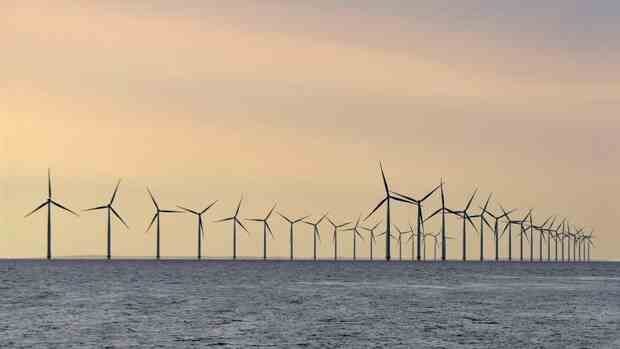The North Sea is to become one of the centers of electricity production in the EU.
(Photo: imago/Hollandse Hoogte)
Berlin For years, Great Britain, a number of EU countries and the European Commission have coordinated the expansion of offshore wind power in the North Sea Energy Cooperation (NSEC). With Brexit, the British left the cooperation with Belgium, Denmark, France, Ireland, Luxembourg, the Netherlands, Norway and Sweden. Now they are at it again.
On Sunday, NSEC members, together with the UK, agreed on a new attempt at cooperation. A declaration of intent was to be signed that evening, which would make it possible to restart operational cooperation with Great Britain – also for Germany.
In particular, joint offshore wind farms, power lines for cross-border electricity exchange (“interconnectors”) and the production of hydrogen on the high seas are planned, according to the Federal Ministry of Economics.
He is very pleased to have the British “on board the North Sea cooperation again,” said Federal Minister of Economics Robert Habeck (Greens) to the Handelsblatt. “This will make it possible in the future to develop concrete joint offshore projects with this important partner country, which will benefit our supply of green electricity,” added the minister.
Top jobs of the day
Find the best jobs now and
be notified by email.
The expansion of offshore wind power plays a key role in the EU’s plans to set up a climate-neutral power supply system: by 2030, at least 60 gigawatts (GW) of offshore wind power should be installed in all sea basins in the EU, and by 2050 it should be 340 GW. Germany wants to make a significant contribution to this.
Conditions for offshore wind power are very good off the UK coast
Offshore wind capacities of 7.8 GW are currently installed in the German part of the North Sea and the Baltic Sea, by 2030 it should be 30 GW and 70 GW by 2045. For classification: 30 GW corresponds to the installed capacity of around 30 nuclear power plants.
However, the electricity yield of wind power is significantly lower: while a nuclear power plant ideally produces electricity almost all 8760 hours of the year, similar to fossil fuel power plants, an offshore wind turbine at favorable locations in the North Sea achieves around 4500 full load hours per year. On land it is often only 2500 hours.
Offshore wind power can play to its strengths particularly when the farms are networked across national borders: the electricity can be better distributed if it finds buyers in several markets at the same time, and the meshing of the wind farms also reduces the costs of connecting to the grid . Great Britain can play an important role in this.
The conditions for offshore wind power off the British coast are very good, and the financial support for wind power expansion is repeatedly praised by the industry as exemplary. German companies have been using this for a long time. The RWE Group alone operates wind turbines off the coast of the United Kingdom with an installed capacity of 3.86 GW.
The work of the North Sea Energy Cooperation is supplemented by the “Pentalateral Energy Forum”, whose members are Germany, France, Belgium, the Netherlands, Luxembourg, Austria and Switzerland. The members agreed on Sunday to intensify their cooperation.
>> Read here: Disco effect and marsh harrier – what is still slowing down the expansion of wind power
The aim of the forum is to interlink the energy markets of the countries more closely in order to increase security of supply and increase efficiency. Minister Habeck said that especially in times of the energy crisis it was “of inestimable importance that we coordinate closely with our neighbors in the Pentalateral Forum on security of supply and crisis management”.
More: Germany opens its first LNG terminal
